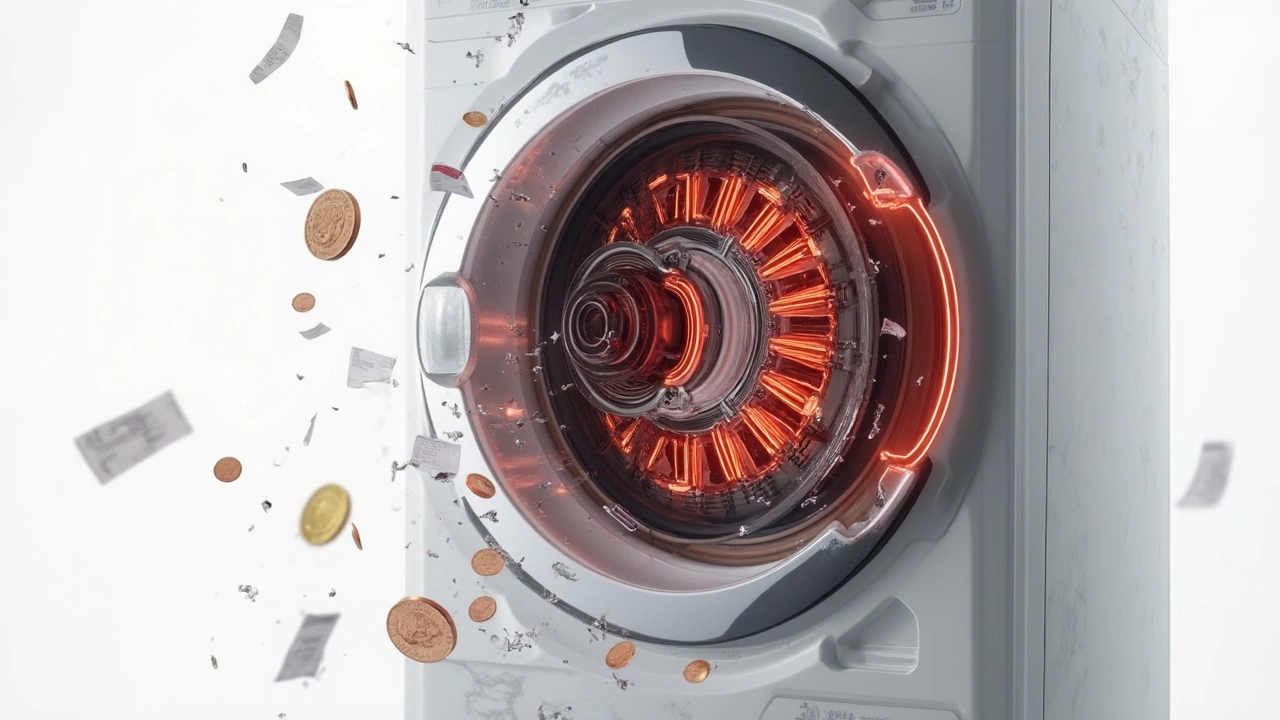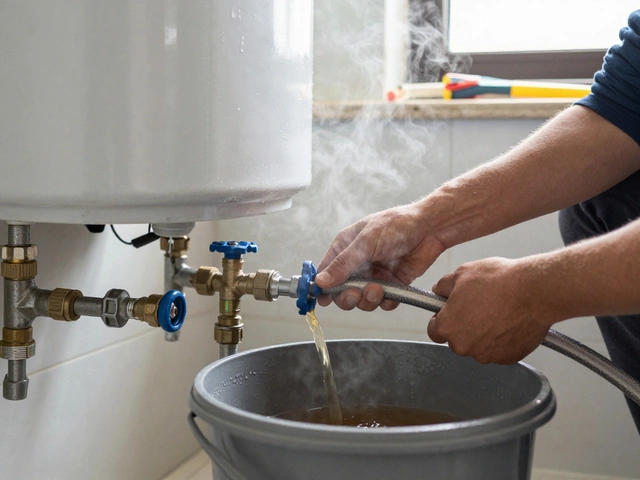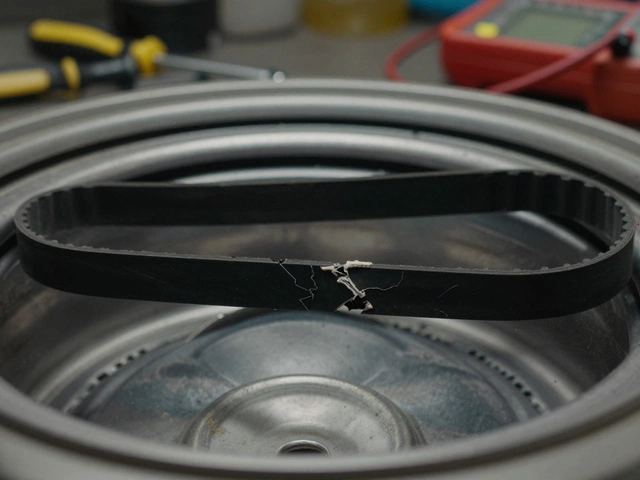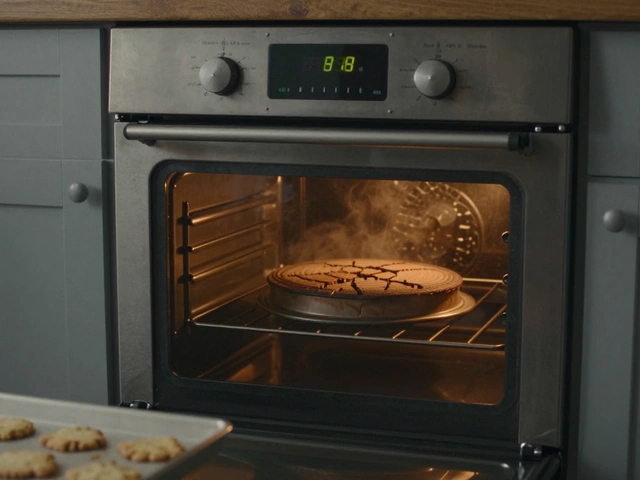Ask any repair tech and most will groan when you mention drum replacement on a washing machine. It's the heavyweight champ for repair costs—sometimes racking up bills that make you wonder if it’s just easier to buy a new washer. The drum, especially in front-load machines, isn’t just a simple piece of metal. It’s heavy, awkward, and usually buried behind everything else. Getting to it means taking your machine practically apart, which means lots of labor hours. Plus, the part itself is pricey because it’s built to handle serious punishment—imagine all those high-speed spins and heavy jeans bouncing around every week.
If your washer is making weird banging noises, or you spot puddles under it, the drum or its bearings could be on their way out. You’re looking at a repair bill that often runs from $400 to $800 (not kidding!), and that’s before you even talk about brand or parts availability. Sometimes, the parts cost more because manufacturers want you buying a new model instead of fixing the old one.
- The True Cost King: The Washer Drum
- Why Drums Are So Expensive
- Control Boards: A Close Second
- Tips to Avoid Major Repairs
The True Cost King: The Washer Drum
No joke—the drum is, hands down, the most expensive part to replace in a washing machine. On a front-loader, you’re not just swapping out a simple barrel. You’re dealing with a heavy, precision-balanced system, often fused with the outer plastic tub. That makes the job a beast even for seasoned repair pros.
Check out this stat: Most replacement washer drums can run between $275 and $500 just for the part. When you toss in labor, which can easily take 3-5 hours at $100 an hour in many areas, the bill can balloon to $800 or more for some washers. Higher-end models, or brands like LG, Samsung, and Whirlpool, sometimes cross the $1,000 mark. At that price, a lot of folks end up junking their old washer and buying new.
The reason for the painful price tag? Most modern washer drums—especially stainless steel ones—are precision parts designed to handle massive forces. The motor spins that thing at crazy speeds, and it has to stay balanced or your machine will start walking across the room. If bearings inside the drum go bad, you usually need to swap the whole drum and tub assembly. Rarely can you just replace a few small pieces anymore.
“Replacing the drum is like open-heart surgery for a washer—the cost is rarely worth it for most machines unless they’re still under warranty.” — Brett McKnight, appliance technician, 16 years in the trade
Here’s a real-world breakdown for drum replacement costs by type and brand:
| Washer Type | Typical Drum Cost | Average Labor Hours | Total Repair Range |
|---|---|---|---|
| Front-Load (Whirlpool) | $350-$500 | 4-5 | $750-$1,000 |
| Front-Load (LG/Samsung) | $400-$700 | 4-6 | $900-$1,200 |
| Top-Load (GE/Maytag) | $250-$400 | 3-4 | $600-$900 |
So, why is the washing machine repair cost so wild for drums? Sometimes you have to pull apart almost the entire machine just to get near the drum. Water leaks, thumping noises, or a tub that feels loose when pressed are classic early signs something’s going wrong. If you catch issues early, bearing and seal kits (if available for your model) can save you a fortune compared to full drum swaps. But on many newer models, drum and bearing parts come as one giant sealed unit—one piece fails, you buy the whole thing.
Why Drums Are So Expensive
If you’ve ever wondered why the bill for a washer drum replacement is so high, you’re not alone. The main issue is that the drum isn’t just a big metal bowl—it’s the core part of your machine, designed to handle serious forces. The drum takes on every heavy load, fights off corrosion from detergent and water, and spins at crazy speeds (some washers reach up to 1200 RPM). That means it’s got to be made from tough stuff, usually stainless steel, which costs way more than plastic or basic steel.
But it’s not just the raw material. The drum size and shape are tailored perfectly for smooth spinning and minimal noise. Manufacturers often seal the drum and tub together, which means if one bit goes out—often the bearings or spider arms—you have to replace the entire assembly. That adds a chunk to the parts bill.
The real kicker is the labor. To get the old drum out and the new one in, techs have to tear down the whole machine. That’s hours of work, and most shops charge by the hour. Add up parts and labor, and it makes sense why most people think twice about drum repairs.
Want to see how it adds up? Here’s a quick breakdown:
| Part / Labor | Average Cost (USD) |
|---|---|
| Drum Assembly | $250 - $500 |
| Labor | $200 - $400 |
| Bearings (if separate) | $50 - $100 |
| Total Estimated Repair | $400 - $800 |
If you’ve got a fancy front-loader or a high-end brand, you’ll pay even more. Plus, not every model has easy-to-get parts, and some brands like to phase out stock fast to nudge you toward a new washer. That’s why the washing machine repair bill for the drum can hit your wallet so hard.

Control Boards: A Close Second
If you think only drums will drain your wallet, think again—the control board sits right behind as one of the most expensive headaches in washing machine repair. The control board, sometimes called the motherboard, is the brain running all the cycles, spin speeds, and fancy features like delay start or quick wash. When it fails, your washer can act totally dead, get stuck on certain cycles, or show weird, random error codes that make zero sense.
Especially in washers made after 2015, control boards are basically circuit-packed tablets for your laundry. They're more complex than people realize. A replacement can range anywhere from $180 to $400 just for the part, and with labor on top, you could land in the $400 to $600 territory. High-end brands sometimes try to lock you into using only their parts, too, pushing prices even higher. Here are some common clues your control board is toast:
- Washer doesn’t respond when you press buttons
- Error codes keep popping up and won’t clear
- Cycles stop mid-way for no reason
- All lights are blinking, or nothing lights up at all
"When a washer control board fails, it’s rarely worth fixing unless it’s a newer, high-end model. Most customers end up replacing the appliance," says Tom Grady, appliance tech with 20 years of field experience.
Check out this quick comparison to see how control board costs stack up with other pricey parts:
| Part Name | Average Replacement Cost (Including Labor) |
|---|---|
| Washer Drum | $400 - $800 |
| Control Board | $400 - $600 |
| Motor | $250 - $450 |
| Pump | $150 - $350 |
If you’re unlucky and a power surge fries your board, some insurance policies might actually cover it—worth checking! And before you agree to the replacement price, make sure the tech is using a new, OEM (original equipment manufacturer) board and not a cheap, unreliable generic.
Tips to Avoid Major Repairs
If saving money sounds good, regular care is your best bet. You don’t need fancy tools or special skills to keep your washer running smooth and skip those giant repair bills. Most problems happen because folks forget the small stuff or guess wrong when something sounds off.
- Washing machine repair bills spike when people ignore weird noises, shaking, or small leaks. Catching issues early usually means cheap fixes—waiting piles on the cost.
- Check your pockets and zippers before every wash. Coins, screws, and metal bits tear up the drum and mess with the pump, which really jacks up the repair bill fast.
- Don’t overload your washer. It’s tempting to run fewer loads, but cramming in that extra towel wears out the drum bearings and suspension. Overloading is enemy number one for modern machines.
- Run a cleaning cycle with vinegar (or a machine cleaner tablet) once a month. It’s quick and it knocks out grit, old detergent, and stink. Clean out the rubber door seal too—mold loves to hide here, especially on front-loaders.
- Level your washer. A machine that rocks or wobbles ruins its drum and shocks, and the fix for those can cost as much as the washer itself.
- Take five minutes to check the hoses a couple times a year. Look for cracks, bulges, or leaks around the fittings. Worn hoses pop and flood your laundry room—replacing them yourself is dirt cheap compared to all-out water damage repair.
Here’s a quick look at how simple habits cut big repair costs:
| Habit | Typical Cost to Fix (if Ignored) | Cost to Prevent |
|---|---|---|
| Ignoring loose drum noises | $500 - $800 | $0 (Just call a tech early) |
| Overloading regularly | $400+ (drum/suspension) | $0 (Run normal loads) |
| Skipping hose checks | $2,000+ (flood repairs) | $20 ($10 hoses) |
| Not cleaning monthly | $150+ (mold/mildew cleanup) | $1 (vinegar or cleaner) |
One last thing? Read your washer’s manual. Dumping less soap than you think actually helps—too much detergent leads to build-up and more repairs. Stick to these basics and you’ll likely dodge those nightmare repair bills for years.









